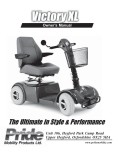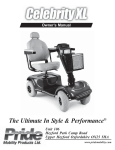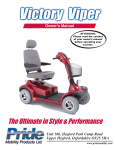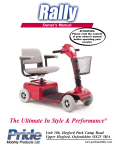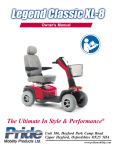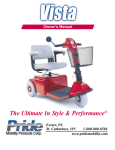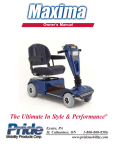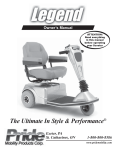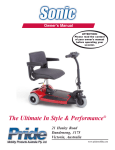Download Go-Go - Pride Mobility Products
Transcript
Owner’s Manual ATTENTION: Please read the content of your owners manual before operating your scooter. The Ultimate In Style & Performance® Unit 106, Heyford Park Camp Road Upper Heyford, Oxfordshire OX25 5HA www.pridemobility.com S A F E T Y G U I D E L I N E S Please read and follow all instructions in this owners manual before attempting to operate your scooter for the first time. If there is anything in this manual you do not understand, or if you require additional assistance for set-up, contact your local authorised Pride provider. Using your Pride product safely depends upon your diligence in following the warnings, cautions, and instructions in this owners manual. Using your Pride product safely also depends upon your own good judgement and/or common sense, as well as that of your provider, caregiver, and/or healthcare professional. Pride is not responsible for injuries and/or damage resulting from any persons failure to follow the warnings, cautions, and instructions in this owners manual. Pride is not responsible for injuries and/ or damage resulting from any persons failure to exercise good judgement and/or common sense. The symbols below are used throughout this owners manual to identify warnings and cautions. It is very important for you to read and understand them completely. WARNING! Failure to heed the warnings in this owners manual may result in personal injury. CAUTION! Failure to heed the cautions in this owners manual may result in damage to your scooter. Copyright © 2004 Pride Mobility Products Ltd. INFMANU2080/REV D/August 2004 C O N T E N T S I. INTRODUCTION ......................................................................................................................... 4 II. SAFETY ......................................................................................................................................... 6 III. SPECIFICATIONS ................................................................................................................... 14 IV. YOUR GO-GO ............................................................................................................................. 16 V. BATTERIES AND CHARGING ............................................................................................ 19 VI. OPERATION ............................................................................................................................... 23 VII. COMFORT ADJUSTMENTS................................................................................................ 24 VIII. DISASSEMBLY AND ASSEMBLY ..................................................................................... 25 IX. OPTIONAL ACCESSORIES ................................................................................................. 28 X. BASIC TROUBLESHOOTING ............................................................................................. 29 XI. CARE AND MAINTENANCE ................................................................................................ 31 XII. WARRANTY ............................................................................................................................... 32 Go-Go 3 I . I N T R O D U C T I O N Welcome to Pride Mobility Products Ltd. (Pride). Congratulations on the purchase of your new Pride Scooter. Your scooter design combines the most advanced state-of-the-art components with modern, attractive styling. We are certain that the design features and trouble-free operation will add convenience to your daily living and ensure complete satisfaction. At Pride, your safety is important to us. Please read and follow all of the instructions in this manual before you attempt to operate your scooter for the first time. These instructions were produced for your benefit. Your understanding of these instructions is essential for the safe operation of your new Pride Scooter. Pride is not liable for damage to property or personal injury arising out of the unsafe use of a Pride Scooter. Pride is also not liable for any property damage or personal injury arising out of the failure of any person and or/user to following the instructions and recommendations set forth in this manual or any other instructions or recommendations contained in other scooter related literature issued by Pride or contained on the Pride Scooter itself. This owners manual is compiled from the latest specifications and product information available at the time of publication. We reserve the right to make changes as they become necessary. Any changes to our products may cause slight variations between the illustrations and explanations in this manual and the product you have purchased. If you experience any problems with your scooter that you are unable to solve, or if you do not feel capable of safely following any of the instructions and/or recommendations contained in this manual, please contact your authorised Pride provider for assistance. Once you understand how to operate and take care of your scooter, we are certain that it will give you years of troublefree service and enjoyment. Information Exchange We want to hear your questions, comments, and suggestions regarding this manual. We would also like to hear about the safety and reliability of your new Pride Scooter and the service you received from your authorised Pride Provider. Please notify us of any change of address so we can keep you apprised of important information regarding safety, new products, and new options that can increase your ability to use and enjoy your Pride Scooter. Please feel free to write us at the address below: Pride Mobility Products Ltd. Unit 106, Heyford Park Camp Road Upper Heyford, Oxfordshire OX25 5HA 4 Go-Go I . I N T R O D U C T I O N My Authorised Pride Provider Is: Name:_______________________________________________________________________________ Address:_____________________________________________________________________________ Phone Number:________________________________________________________________________ Quick Reference Information: Scooter Model:________________________________________________________________________ Serial Number:__________________________________________________________________________ Purchase Date:________________________________________________________________________ NOTE: If you ever lose or misplace your product registration card or this owners manual, contact us and we will be glad to send you a new one immediately. Go-Go 5 I I . S A F E T Y GENERAL WARNING! Do not operate your new scooter for the first time without completely reading and understanding this owners manual. Your Go-Go is a state-of-the-art life-enhancement device designed to increase mobility. Pride provides an extensive variety of products to best fit the individual needs of the scooter user. Please be aware that the final selection and purchasing decision regarding the type of scooter to be used is the responsibility of the scooter user who is capable of making such a decision and his/her healthcare professional (i.e., medical doctor, physical therapist, etc.). The contents of this manual are based on the expectation that a mobility device expert has properly fitted the scooter to the user and has assisted the prescribing healthcare professional and/or your authorised Pride Provider in the instruction process for the use of the product. There are certain situations, including some medical conditions, where the scooter user will need to practice operating the scooter in the presence of a trained attendant. A trained attendant can be defined as a family member or care professional specially trained in assisting a scooter user in various daily living activities. As you begin using your scooter during daily activities, you will probably encounter situations in which you will need some practice. Simply take your time and you will soon be in full and confident control as you maneuver through doorways, on and off elevators, up and down ramps, and over moderate terrain. Below are some precautions, tips, and other safety considerations that will help the user become accustomed to operating the scooter safely. MODIFICATIONS Pride has designed and engineered your scooter to provide maximum mobility and utility. A wide range of accessories is available from your authorised Pride Provider to further customize your scooter to better suit your needs and/or preferences. However, under no circumstances should you modify, add, remove, or disable any feature, part, or function of your scooter. WARNING! Do not modify your scooter in any way unless authorised by Pride. Unauthorised modifications may result in personal injury and/or damage to your scooter. REMOVABLE PARTS WARNING! Do not attempt to lift or move a scooter by any of its removable parts. Personal injury and damage to the scooter may result. ELECTROMAGNETIC FIELDS Your scooters road performance features may be influenced by electromagnetic fields caused by cellular telephones or other radiating devices, such as hand-held radios, radio and television stations, wireless computer links, microwave sources, and paging transmitters. 6 Go-Go I I . S A F E T Y PRE-RIDE SAFETY CHECK Get to know the feel of your scooter and its capabilities. Pride recommends that you perform a safety check before each use to make sure your scooter operates smoothly and safely. For details on how to perform these necessary inspections, see XI. Care and Maintenance. Perform the following inspections prior to using your scooter: n Check all electrical connections. Make sure they are tight and not corroded. n Check the brakes. n Check battery charge. If you discover a problem, contact your authorised Pride Provider for assistance. WEIGHT LIMITATIONS Your Go-Go is rated for a 113 kg (250-lb.) maximum weight limit. WARNING! Exceeding the weight limit voids your warranty and may result in personal injury and damage to your scooter. Pride will not be held responsible for injuries and/or property damage resulting from failure to observe weight limitations. WARNING! Do not carry passengers on your scooter. Carrying passengers may result in personal injury and/or property damage. GETTING ONTO AND OFF OF YOUR SCOOTER Getting onto and off of your scooter requires a good sense of balance. Please observe the following safety tips when getting onto and off of your scooter: n Power down your scooter. See VI. Operation. n Ensure that your scooter is not in freewheel mode. See IV. Your Go-Go. n Make certain that the seat is locked into place and the key is removed from the key switch. WARNING! Position yourself as far back as possible in the scooter seat to prevent the scooter from tipping and causing injury. WARNING! If you have the optional seat upgrade with armrests, avoid using your armrests for weight bearing purposes. Such use may cause your Go-Go to tip and cause personal injury. WARNING! Avoid putting all of your weight on the floorboard. Such use may cause the scooter to tip and cause personal injury. POSITIONING BELTS Your authorised Pride Provider, therapist(s), and other healthcare professionals are responsible for determining your requirement for a positioning belt in order to operate your scooter safely. WARNING! If you require a positioning belt to safely operate your scooter, make sure it is fastened securely. Serious personal injury may result if you fall from the scooter. Go-Go 7 I I . S A F E T Y INCLINE INFORMATION More and more buildings have ramps with specified degrees of inclination designed for easy and safe access. Some ramps may have turning switchbacks (180-degree turns) that require you to have good cornering skills on your scooter. n Proceed with extreme caution as you approach the downgrade of a ramp or other incline. n Take wide swings with your scooters front wheel(s) around any tight corners. If you do that, the scooters rear wheels will follow a wide arc, not cut the corner short, and not bump into or get hung up on any railing corners. n When driving down a ramp, keep the scooters speed adjustment set to the slowest speed setting to ensure a safely controlled descent. See IV. Your Go-Go. n Avoid sudden stops and starts. When climbing an incline, try to keep your scooter moving. If you must stop, start up again slowly, and then accelerate cautiously. When driving down an incline, do so by setting the speed adjustment dial to the slowest setting and driving in the forward direction only. If your scooter starts to move down the incline faster than you anticipated or desired, allow it to come to a complete stop by releasing the throttle control lever. Then push the throttle control lever forward slightly to ensure a safely controlled descent. WARNING! When climbing an incline, do not zigzag or drive at an angle up the face of the incline. Drive your scooter straight up the incline. This greatly reduces the possibility of a tip or a fall. Always exercise extreme caution when negotiating an incline. WARNING! You should not travel up or down a potentially hazardous incline (i.e., areas covered with snow, ice, cut grass, or wet leaves). WARNING! When on any sort of an incline or decline, never place the scooter in freewheel mode while seated on it or standing next to it. Other inclines may be natural or, if man-made, not designed specifically for scooters. Figures 1 and 1A illustrate your scooters stability and its ability to climb grades under various weight loads and under controlled testing conditions. These tests were conducted with the Go-Gos seat in the highest position and adjusted rearward on the seat base to its farthest rearward position. Use this information as a guideline. Your scooters ability to travel up inclines is affected by your weight, your scooters speed, your angle of approach to the incline, and your scooter setup. 68 kg/ 91 kg/ 113 kg/ 11 stone 14 stone 18 stone (150 lbs.) (200 lbs.) (250 lbs.) 10.5% 14.1% 12.3% Figure 1. Maximum Recommended Incline Angles 68 kg/ 91 kg/ 113 kg/ 11 stone 14 stone 18 stone (150 lbs.) (200 lbs.) (250 lbs.) 12.3% 8.7% 10.5% Figure 1A. Maximum Recommended Incline Angles With Rear Basket Or Oxygen Tank WARNING! Never use an oxygen tank weighing more than 5.8 kg (13 lbs.). Never fill the rear basket with contents exceeding 5.8 kg (13 lbs.). WARNING! Any attempt to climb or descend slopes steeper than that shown in figures 1 and 1A may put your scooter in an unstable position and cause it to tip, resulting in personal injury. 8 Go-Go I I . S A F E T Y When you approach an incline, it is best to lean forward. See figures 2 and 2A. This shifts the centre of gravity of you and your scooter toward the front of the scooter for improved stability. NOTE: When negotiating ramps, if the throttle control lever is released while moving forward, the powered scooter may "rollback" approximately 30.5 cm (1 foot) before the brake engages. If the throttle control lever is released while moving in reverse, the powered scooter may "rollback" approximately one meter (3 feet) before the brake engages.. WARNING! Do not exceed the incline guidelines or any other specifications presented in this manual. Figure 2. Normal Driving Position Figure 2A. Increased Stability Driving Position CORNERING INFORMATION Excessively high cornering speeds can create the possibility of tipping. Factors which affect the possibility of tipping include, but are not limited to, cornering speed, steering angle (how sharply you are turning), uneven road surfaces, inclined road surfaces, riding from an area of low traction to an area of high traction (such as passing from a grassy area to a paved area especially at high speed while turning), and abrupt directional changes. High cornering speeds are not recommended. If you feel that you may tip over in a corner, reduce your speed and steering angle (i.e., lessen the sharpness of the turn) to prevent your scooter from tipping. WARNING! When cornering sharply, reduce your speed. When using your scooter at higher speeds, do not corner sharply. This greatly reduces the possibility of a tip or fall. To avoid personal injury or property damage, always exercise common sense when cornering. BRAKING INFORMATION Your scooter is equipped with these powerful brake systems: n Regenerative: Uses electricity to rapidly slow the vehicle when the throttle control lever returns to the centre/ stop position. n Disc Park Brake: Activates mechanically after regenerative braking slows the vehicle to near stop, or when power is removed from the system for any reason. Go-Go 9 I I . S A F E T Y OUTDOOR DRIVING SURFACES Your scooter is designed to provide optimum stability under normal driving conditionsdry, level surfaces composed of concrete, blacktop, or asphalt. However, Pride recognizes that there will be times when you will encounter other surface types. For this reason, your scooter is designed to perform admirably on packed soil, grass, and gravel. Feel free to use your scooter safely on lawns and in park areas. n n n n Reduce your scooters speed when driving on uneven terrain and/or soft surfaces. Avoid tall grass that can become tangled in the running gear. Avoid loosely packed gravel and sand. If you feel unsure about a driving surface, avoid that surface. STATIONARY OBSTACLES (STEPS, KERBS, ETC.) Always approach a kerb straight on whether ascending or descending it. See figures 3 and 3A. WARNING! Do not drive near raised surfaces, unprotected ledges, and/or drop-offs (kerbs, porches, stairs, etc.). WARNING! Do not attempt to have your scooter climb or descend an obstacle that is inordinately high. Serious personal injury and/or damage may result. WARNING! Do not attempt to have your scooter proceed rearward down any step, kerb, or other obstacle. This may cause the scooter to tip and cause personal injury. WARNING! Be sure your scooter is traveling perpendicular to any kerb you may be required to ascend or descend. See figures 3 and 3A. WARNING! Do not attempt to negotiate a kerb that has a height greater than 5 cm (two inches). KERB KERB Figure 3. Correct Kerb Approach 10 Figure 3A. Incorrect Kerb Approach Go-Go I I . S A F E T Y STREETS AND ROADWAYS WARNING! You should not operate your scooter on public streets and roadways. Be aware that it may be difficult for traffic to see you when you are seated on your scooter. Obey all local pedestrian traffic rules. Wait until your path is clear of traffic, and then proceed with extreme caution. INCLEMENT WEATHER PRECAUTIONS WARNING! Pride recommends that you do not operate your scooter in icy or slippery conditions or on salted surfaces (i.e., walks or roads). Such use may result in an accident, personal injury, or adversely affect the performance and safety of your scooter. WARNING! Pride recommends that you do not expose your scooter to any type of moisture at any time (rain, snow, mist, or wash). Such exposure can damage your scooter. Never operate your scooter if it has been exposed to moisture until it has dried thoroughly. FREEWHEEL MODE Your scooter is equipped with a manual freewheel lever that, when disengaged, allows the scooter to be pushed. For more information about how to place your scooter into and out of freewheel mode, See IV. Your Go-Go. WARNING! Do not use your scooter in freewheel mode without an attendant present. Personal injury may result. WARNING! Do not attempt to personally place your scooter in freewheel mode while seated on it. Personal injury may result. WARNING! Do not place your scooter in freewheel mode while on an incline. The scooter could roll uncontrollably on its own, causing personal injury. PREVENTING UNINTENDED MOVEMENT WARNING! If you anticipate being seated in a stationary position for an extended period of time, turn off the power. This will prevent unexpected motion from inadvertent throttle control lever contact. Failure to do so may result in personal injury. STAIRS AND ESCALATORS Scooters are not designed to travel up or down stairs or escalators. Always use an elevator. WARNING! Do not use your scooter to negotiate steps or escalators. You may cause injury to yourself and to others and damage your scooter. DOORS n Determine if the door opens toward or away from you. n Use your hand to turn the knob or push the handle or push-bar. n Drive your scooter gently and slowly forward to push the door open. Or drive your scooter gently and slowly rearward to pull the door open. Go-Go 11 I I . S A F E T Y ELEVATORS Modern elevators have a door edge safety mechanism that, when pushed, reopens the elevator door(s). n If you are in the doorway of an elevator when the door(s) begin to close, push on the rubber door edge or allow the rubber door edge to contact the scooter and the door will reopen. n Use care that pocketbooks, packages, or scooter accessories do not become caught in elevator doors. LIFT/ELEVATION PRODUCTS If you will be traveling with your scooter, you may find it necessary to use a lift/elevation product to aid in transportation. Pride recommends that you closely review the instructions, specifications, and safety information set forth by the manufacturer of the lift/elevation product before using that product. BATTERIES In addition to following the warnings below, be sure to comply with all other battery handling information. For more information about your scooters batteries, see V. Batteries and Charging. WARNING! Battery posts, terminals, and related accessories contain lead and lead compounds. Wash hands after handling. WARNING! Always protect the batteries from freezing and never charge a frozen battery. Charging a frozen battery may result in personal injury and/or damage to the battery. MOTOR VEHICLE TRANSPORT Currently, there are no standards approved for tie-down systems in a moving vehicle of any type to transport a person while seated in a scooter. Although your scooter may be equipped with a positioning belt, this belt is not designed to provide proper restraint during motor vehicle transport. Anyone traveling in a motor vehicle should be properly secured in the motor vehicle seat with safety belts fastened securely. WARNING! Do not sit on your scooter while it is in a moving vehicle. Personal injury and/or property damage may result. WARNING! Always be sure your scooter is properly secured when it is being transported. Failure to do so may result in personal injury and/or damage to your scooter. REACHING AND BENDING Avoid reaching or bending while driving your scooter. When reaching, bending, or leaning while seated on your scooter, it is important to maintain a stable center of gravity and keep the scooter from tipping. Pride recommends that the scooter user determine his/her personal limitations and practice bending and reaching in the presence of a qualified healthcare professional. WARNING! Do not bend, lean, or reach for objects if you have to pick them up from the floor by reaching down between your knees. Movements such as these may change your center of gravity and the weight distribution of the scooter and cause your scooter to tip, possibly resulting in personal injury. Keep your hands away from the tyres when driving. 12 Go-Go I I . S A F E T Y PRESCRIPTION DRUGS/PHYSICAL LIMITATIONS The scooter user must exercise care and common sense when operating his/her scooter. This includes awareness of safety issues when taking prescribed or over-the-counter drugs or when the user has specific physical limitations. WARNING! Consult your physician if you are taking prescribed or over-the-counter medication or if you have certain physical limitations. Some medications and limitations may impair your ability to operate your scooter in a safe manner. ALCOHOL The scooter user must exercise care and common sense when operating his/her scooter. This includes awareness of safety issues while under the influence of alcohol. WARNING! Do not operate your scooter while you are under the influence of alcohol, as this may impair your ability to drive safely. Go-Go 13 I I I . S P E C I F I C AT I O N S 34.25 cm (13.5") 71.75 cm - 74.30 cm (28.25" - 29.25") 30.5 cm - 33 cm (12" - 13") 3 cm (1.25") 3-Wheel 94 cm (37") 4-Wheel 99 cm (39") 43 cm (17") 40.60 cm (16") 3-Wheel 81 cm (32") Turning Radius 4-Wheel 109 cm (43") Turning Radius (48.25 cm) (19") Figure 4. Go-Go Dimensions 5 cm (2") 19 cm (7.5") Figure 4A. Front And Rear Tyre Dimensions 14 Go-Go I I I . Model Number Class of Use Colours Overall Length Overall Width Total Weight Without Batteries Heaviest Piece When Disassembled Turning Radius Speed (Maximum) Range Per Charge* Ground Clearance Weight Capacity Seating Drive System Dual Braking System Tyres Battery Requirements Battery Charger Warranty Accessories S P E C I F I C AT I O N S 3-Wheel: SCUK40 4-Wheel: SCUK44 A Red, Blue 3-Wheel: 94 cm (37 in.) 4-Wheel: 99 cm (39 in.) 48.25 cm (19 in.) 3-Wheel: 30 kg (67 lbs.) 4-Wheel: 34.5 kg (76 lbs.) Rear section: 13.5 kg (29.75 lbs.) 3-Wheel: 81 cm (32 in.) 4-Wheel: 109 cm (43 in.) Variable up to 6.5 km/h (4.1 mph) (With 12 AH batteries) Up to 16 km (10 miles) 3 cm (1.25 in.) 113 kg (250 lbs.) Standard: Type: Foldable Dimensions: 43 cm (17 in.) width x 40.60 cm (16 in.) depth (usable) x 34.25 cm (13.5 in.) height (usable) Material: Black Vinyl Optional deluxe seating with armrests also available. Rear-wheel drive, sealed transaxle, 24 volt DC motor Electronic, regenerative, and electromechanical Type: solid; front and rear: 5 cm x 19 cm (2 in. x 7.5 in.) Type: Two 12 volt, deep cycle, SLA or gel cell Size: 12 AH 2-amp, off-board 2-year limited Double cane/crutch holder; walker holder; oxygen tank holder; quad cane holder; front basket; safety flag; rear basket; cup holder (for deluxe seat only); single crutch holder; wishbone crutch holder; forearm crutch holder (clip); double crutch holder (clip); dust cover * Varies with user weight, terrain type, battery charge, battery condition, and tyre condition. Go-Go 15 I V. YO U R G O - G O TILLER CONSOLE The tiller console houses all controls needed to drive your scooter, including the key switch, throttle control levers, horn button, speed adjustment dial, and the battery condition meter. See figure 5. WARNING! Do not expose the tiller console to moisture. In the event that the tiller console does become exposed to moisture, do not attempt to operate your scooter until the tiller console has dried thoroughly. BATTERY CONDITION METER SPEED ADJUSTMENT DIAL HORN BUTTON KEY (INSERTED INTO KEY SWITCH) THROTTLE CONTROL LEVER Figure 5. Tiller Console THROTTLE CONTROL LEVER Key Switch n Fully insert the key into the key switch to power up (turn on) your scooter. n Remove the key from the key switch to power down (turn off) your scooter. Throttle Control Levers These levers allow you to control the forward speed and the reverse speed of your scooter up to the maximum speed you preset with the speed adjustment dial. n Place your right hand on the right handgrip and your left hand on the left handgrip. n Use your right thumb to push the right side of the lever to disengage your scooters brakes and move forward. n Release the lever and allow your scooter to come to a complete stop before pushing the other side of the lever to move in reverse. n When the throttle is completely released, it automatically returns to the center stop position and engages your scooters brakes. Horn Button The key must be fully inserted into the key switch for the horn to be operational. n This button activates a warning horn. n Do not hesitate to use the warning horn when doing so may prevent accident or injury. Speed Adjustment Dial This dial allows you to preselect and limit your scooters top speed. n The image of the tortoise represents the slowest speed setting. n The image of the hare represents the fastest speed setting. Battery Condition Meter When the key is fully inserted into the key switch, this meter indicates approximate battery strength. For further information on the battery conditon meter, see V. Batteries and Charging. 16 Go-Go I V. Y O U R G O - G O REAR SECTION The manual freewheel lever, anti-tip wheels, and motor/transaxle assembly are located on the rear section of your scooter. See figure 6. MANUAL FREEWHEEL LEVER WARNING! Before placing your scooter into or taking it out of freewheel mode, remove the key from the key switch. Never sit on a scooter when it is in freewheel mode. Never put a scooter in freewheel mode on any incline. Manual Freewheel Lever ANTI-TIP WHEELS Whenever you need or want to push your scooter for short distances, you can put it in Figure 6. Rear Section freewheel mode. n The manual freewheel lever is located at the top right of the rear section. n Push forward on the manual freewheel lever to disable the drive system and the brake system. n You may now push your scooter. n Pull the manual freewheel lever rearward to reengage the drive and the brake systems; this takes your scooter out of freewheel mode. WARNING! Follow these safety rules when using the freewheel mode: n Do not disengage the drive motor when your Go-Go is on an incline; your scooter could roll down on its own and cause injury. n Before placing your Go-Go in or taking it out of freewheel mode, ensure the key is removed from the key switch. n Never sit on a scooter when it is in freewheel mode. n When you have finished pushing your scooter, always return it to the drive (freewheel lever pulled rearward) mode to lock the brakes. WARNING! Never operate the manual freewheel lever while seated on the scooter or when the scooter is on an incline. OPERATING THE MANUAL FREEWHEEL LEVER n Only put the scooter in freewheel mode when on a flat surface with the key removed. n Always pull REARWARD FIRMLY on the manual freewheel lever to put the scooter into drive mode. n Always push FORWARD FIRMLY to put the scooter into freewheel mode. Anti-Tip Wheels The anti-tip wheels are an integral and important safety feature of your scooter. Do not, under any circumstances, remove the anti-tip wheels from your scooter. Motor/Transaxle Assembly (Not Shown) The motor/transaxle assembly is an electromechanical unit that converts electrical energy from your scooters batteries into the controlled mechanical energy that drives the scooters wheels. Go-Go 17 I V. Y O U R G O - G O BATTERY PACK The Go-Go is equipped with an innovative, easy to remove battery pack. A handle on the top of the battery pack makes it easy to lift the pack off of the scooter with one hand. The battery pack contains two 12 volt, 12 AH batteries; the charger power lead receptacle; and the main circuit breaker (reset button). See figure 7. BATTERY PACK HANDLE BATTERY PACK CHARGER POWER LEAD RECEPTACLE MAIN CIRCUIT BREAKER (RESET BUTTON) Figure 7. Battery Pack Charger Power Lead Receptacle The scooters 3-pin off-board charger lead plugs into this receptacle. Main Circuit Breaker (Reset Button) When the voltage in your scooters batteries becomes low or the scooter is heavily strained because of excessive loads or steep inclines, the main circuit breaker may trip to protect the motor and electronics from damage. n The main circuit breaker reset button pops out when the breaker trips. n When the breaker trips, the entire electrical system of your scooter shuts down. n Allow a minute or two for your scooters electronics to rest. n Push in the reset button to reset the main circuit breaker. n If the main circuit breaker trips frequently, you may need to charge your batteries more often. You may also need to have your authorised Pride Provider perform a load test on your scooters batteries. OFF-BOARD BATTERY CHARGER The off-board battery charger, when plugged into the charger power lead receptacle (located on the battery pack) and a standard wall outlet, charges the scooters batteries. See figure 7A. Figure 7A. Off-Board Battery Charger 18 Go-Go V. BATTERIES AND CHARGING Your scooter is equipped with two sealed, maintenance free 12 AH batteries. n Charge the batteries prior to using your scooter for the first time. n Keep the batteries fully charged to keep your scooter running smoothly. READING YOUR BATTERY VOLTAGE The battery condition meter on the tiller console uses a colour code to indicate the approximate strength of your batteries. Green indicates fully charged batteries, yellow a draining charge, and red indicates that an immediate recharge is necessary. See figure 8. To check the battery strength during charging, you must first unplug the charger power lead and power up your scooter by inserting the key into the key switch. CHARGING YOUR BATTERIES Figure 8. Battery Condition Meter WARNING! Never use an extension lead to plug in your battery charger. Plug the charger directly into a properly wired standard wall outlet. The scooters battery pack can be charged on or off the scooter. Follow these easy steps to charge your batteries safely: 1. Position your scooter close to a standard wall outlet. 2. Remove the key from the key switch. 3. Make certain that the manual freewheel lever is in the drive (pushed back) position. 4. Remove the charger power lead receptacle cover from the charger power lead receptacle and plug the 3-pin off-board charger power lead into the receptacle. 5. Extend the charger power lead from the off-board battery charger and plug it into the wall outlet. It is recommended that you charge your batteries for 8 to 14 hours. There are two LEDs (Light Emitting Diodes) on the chargerwhen lit: n Green indicates power to the charger. n Red indicates the batteries are charging. When the red LED is no longer lit, charging is complete. 6. When the batteries are fully charged, unplug the off-board charger power lead from the wall outlet and then from the charger power lead receptacle. 7. Replace the charger power lead receptacle cover. NOTE: There is a charger inhibit function on your Go-Go. The Go-Go will not run and the battery condition meter will not operate if the charger cord is not disconnected from the battery pack. BATTERIES AND CHARGING-FREQUENTLY ASKED QUESTIONS (FAQS) How does the charger work? When your scooters battery voltage is low, the charger works harder, sending more electrical current to the batteries to bring up their charge. As the voltage approaches full charge, the charger sends less and less electrical Go-Go 19 V. B AT T E R I E S AND CHARGING current to the batteries. When the batteries are fully charged, the current sent by the charger is at nearly zero amperage. Therefore, when the charger is plugged in, it maintains the charge on your scooters batteries, but does not overcharge them. We do not recommend that you charge your scooters batteries for more than 24 consecutive hours. What if my scooters batteries wont charge? n Ensure that both ends of the charger power lead are inserted fully. How often must I charge the batteries? Two major factors must be considered when deciding how often to charge your scooters batteries: n All day scooter use on a daily basis. n Infrequent or sporadic scooter use. With these considerations in mind, you can determine how often and for how long you should charge your scooters batteries. We designed the off-board charger so that it will not overcharge your scooters batteries. However, you may encounter some problems if you do not charge your batteries often enough and if you do not charge them on a regular basis. Following the five guidelines below will provide safe and reliable battery operation and charging. n If you use your scooter daily, charge its batteries as soon as you finish using it for the day. Your scooter will be ready each morning to give you a full day of service. We recommend that you charge your scooters batteries for 8 to 14 hours after daily use. n If you use your scooter once a week or less, charge its batteries at least once a week for 12 to 14 hours at a time. n Keep your scooters batteries fully charged. n Avoid deeply discharging your scooters batteries. n Do not charge your scooters batteries for more than 24 consecutive hours. How can I get maximum range or distance per charge? Rarely will you have ideal driving conditionssmooth, flat, hard driving surfaces with no wind or curves. Often you will face hills, pavement cracks, uneven and loosely packed surfaces, curves, and wind, all of which affect the distance or running time per battery charge. Below are a few suggestions for obtaining the maximum range per battery charge. n Fully charge your scooters batteries prior to use. n Plan your route to avoid as many hills, cracked, broken, or soft surfaces as possible. n Limit your baggage weight to essential items. n Try to maintain an even speed while your scooter is in motion. n Avoid stop-and-go driving. What about public transportation? If you intend to use public transportation with your scooter, you must contact the transportation provider in advance to determine their specific requirements. What type and size battery should I use? Your scooter comes equipped with two deep-cycle batteries that are sealed and maintenance free. Both sealed lead-acid and gel cell are deep-cycle batteries that are similar in performance. Do not use wet-cell batteries, which have removable caps. 20 Go-Go V. BATTERIES AND CHARGING Use these specifications to reorder deep-cycle batteries from your authorised Pride Provider: Type: Voltage: Size: Battery Specifications Deep-cycle (sealed lead-acid or gel cell) 12 volts each 12 AH Why do my new batteries seem weak? Deep-cycle batteries employ a different chemical technology than that used in car batteries, nickel-cadmium batteries (nicads), or in other common battery types. Deep-cycle batteries are specifically designed to provide power, drain down their charge, and then accept a relatively quick recharge. We work closely with our battery manufacturer to provide batteries that best suit your scooters specific electrical demands. Fresh batteries arrive daily at Pride and are shipped fully charged to our customers. During shipping, the batteries may encounter temperature extremes that may influence their initial performance. Heat diminishes the charge on the battery; cold slows the available power and extends the time needed to recharge the battery. It may take a few days for the temperature of your scooters batteries to stabilise and adjust to their new room or ambient temperature. WARNING! If your scooters batteries become frozen, do not attempt to charge them. Cold or frozen batteries should be allowed to warm up for several days prior to recharging. It takes a few charging cycles (partial draining followed by full recharging) to establish the critical chemical balance that is essential to a deep-cycle batterys peak performance and long life. Follow these steps to properly break-in your scooters new batteries for maximum efficiency and service life. 1. Fully recharge any new battery prior to its initial use. This charging cycle brings the battery up to about 88% of its peak performance level. 2. Operate your new scooter in familiar and safe areas. Drive slowly at first, and do not travel too far from your home or familiar surroundings until you have become accustomed to your scooters controls. 3. Fully recharge the batteries. They should be at over 90% of their peak performance level. 4. Operate your scooter again. 5. Fully recharge the batteries again. 6. After four or five charging cycles, the batteries are able to receive a charge of 100% of their peak performance level and are able to last for an extended period of time. How can I ensure maximum battery life? Fully charged deep-cycle batteries provide reliable performance and extended battery life. Keep your scooters batteries fully charged whenever possible. Batteries that are regularly and deeply discharged, infrequently charged, or stored without a full charge may be permanently damaged, causing unreliable performance and limited service life. How should I store my scooter and its batteries? See XI. Care and Maintenance. Go-Go 21 V. B AT T E R I E S AND CHARGING REPLACING YOUR SCOOTER’S BATTERIES WARNING! Battery posts, terminals, and related accessories contain lead and lead compounds. Wash hands after handling. Battery Removal 1. Remove the battery pack from the scooter. 2. Turn the pack upside down. 3. Remove all screws that hold the battery pack halves together. 4. Flip the battery pack back over so the handle is facing up and remove the lid. 5. Remove the red (+) positive and black (-) negative battery leads from the battery by pulling them straight away from the battery terminal. 6. Remove the battery or batteries to be replaced. Battery Replacement 1. Put the new battery or batteries back into the battery pack (battery terminals facing up). 2. Reconnect the two (2) battery leads to the battery terminals. n Red lead to (+) positive terminal. n Black lead to (-) negative terminal. 3. Replace the lid and carefully flip the battery pack over so the handle is facing down. 4. Replace and tighten all the screws that hold the battery pack together. 5. Reinstall the battery pack back onto the scooter. BATTERY DISPOSAL AND RECYCLING If you encounter a damaged or cracked battery, immediately enclose it in a plastic bag and call your authorised Pride Provider for instructions on disposal. Your authorised Pride Provider will also have the necessary information on battery recycling, which is our recommended course of action. 22 Go-Go V I . O P E R AT I O N BEFORE GETTING ON YOUR SCOOTER n Have you fully charged the batteries? See V. Batteries and Charging. n Is the manual freewheel lever in the drive (rearward) position? Never leave the manual freewheel lever pushed forward unless you are manually pushing your scooter. n Is the tiller lock knob in the unlocked position? See VIII. Disassembly and Assembly. GETTING ONTO YOUR SCOOTER 1. Make certain that the key is removed from the key switch. WARNING! Never attempt to board or exit your scooter without first removing the key from the key switch. This will prevent the scooter from moving if accidental throttle control lever contact is made. 2. 3. 4. 5. Stand at the side of your scooter. Make certain that the seat is locked securely in position. Position yourself comfortably and securely in the seat. Make certain that your feet are safely on the floorboard. PRE-RIDE ADJUSTMENTS AND CHECKS n Are you positioned comfortably in the seat? n Is the seat at the proper height? n Is the seat securely in place? n Is the tiller at a comfortable setting and locked securely in place? See VII. Comfort Adjustments. n Is the key fully inserted into the key switch? See IV. Your Go-Go. n Does the scooters horn work properly? n Is your proposed path clear of people, pets, and obstacles? n Have you planned your route to avoid adverse terrain and as many inclines as possible? OPERATING YOUR SCOOTER After planning your route: n Set the speed adjustment dial to your desired speed. n Press your thumb against the appropriate throttle control lever. n The electromechanical disc park brake automatically disengages and the scooter accelerates smoothly to the speed you preselected with the speed adjustment dial. n Pull on the left handgrip to steer your scooter to the left. n Pull on the right handgrip to steer your scooter to the right. n Move the tiller to the center position to drive straight ahead. n Release the throttle control lever to decelerate and come to a complete stop. n The electromechanical disc park brake automatically engages when your scooter comes to a stop. GETTING OFF OF YOUR SCOOTER 1. Bring your scooter to a complete stop. 2. Remove the key from the key switch. 3. Carefully and safely get out of the seat to either side of your scooter. Go-Go 23 VII. COMFORT ADJUSTMENTS TILLER ANGLE ADJUSTMENT WARNING! Remove the key from the key switch before adjusting the tiller. Never attempt to adjust the tiller while the scooter is in motion. Your scooter is equipped with an adjustable pivoting tiller. 1. Turn the tiller adjustment knob anticlockwise to loosen the tiller. See figure 9. 2. Move the tiller to a comfortable position. 3. Turn the tiller adjustment knob clockwise to secure the tiller in position. TILLER ADJUSTMENT KNOB NOTE: In order to lower the tiller to the scooter deck, you must first remove the seat. SEAT ROTATION The seat can be rotated to one of four positions in 90° increments. 1. Pull up slightly on the seat. 2. Rotate the seat 90° or 180° to the right or left to the desired position. 3. Lower the seat and be sure it is locked into position. SEAT HEIGHT ADJUSTMENT The seat can be repositioned to different heights. See figure 10. 1. Remove the seat from your scooter. 2. Use the attached ring to pull and remove the detent pin from the lower seat post. 3. Raise or lower the upper seat post to the desired seat height. 4. While holding the upper seat post at that height, match up the adjustment holes in the upper and lower seat posts. 5. Fully insert the detent pin. 6. Replace the seat. NOTE: The supplied nut, bolt, and washers can be used as an alternative to the ball detent pin. 24 Figure 9. Tiller Adjustment UPPER SEAT POST LOWER SEAT POST DETENT PIN Figure 10. Seat Height Adjustment Go-Go V I I I . D I S A S S E M B LY A N D A S S E M B LY DISASSEMBLY No tools are required to disassemble or assemble your scooter. Always disassemble or assemble your scooter on a level, dry surface with sufficient room for you to work. Keep in mind that the disassembled sections of a scooter take up more floor space than the assembled scooter. You can disassemble the Go-Go into four pieces: the seat, the front section, the rear section, and the battery pack. See figure 11. FRONT SECTION REAR SECTION SEAT BATTERY PACK Figure 11. Disassembled Scooter WARNING! Lifting weight beyond your physical capability may result in personal injury. Ask for assistance when necessary before disassembling your scooter. Before disassembling the scooter, remove the key and place the manual freewheel lever in the rearward (drive) position. 1. From the unlocked position (see figure 12), lock the front wheel by pushing the tiller lock knob in and turning it clockwise 90°. See figure 12A. UNLOCKED POSITION LOCKED POSITION Figure 12. Tiller Lock Knob (Unlocked) Figure 12A. Tiller Lock Knob (Locked) WARNING! Before getting onto your scooter, always check that the tiller lock knob is in the unlocked position. Attempting to ride your scooter with the tiller lock knob in the locked position can result in personal injury. 2. Remove the seat by lifting it straight up and off of the scooter. Go-Go 25 V I I I . D I S A S S E M B LY A N D A S S E M B LY 3. Remove the battery pack. n The battery pack is held in place by a reusable fastener. Use the battery pack handle to pull the battery pack up and away from the scooter. See figure 13. 4. Unplug the front-to-rear harness. See figure 14. Figure 13. Removing Battery Pack Figure 14. Front-To-Rear Harness Toggle Latch Release 1. Push in the toggle latch release button while pulling forward on the toggle latch. See figure 15. 2. Rotate the toggle latch buckle over the top of the toggle latch until it snaps into its retainer. See figure 15A. . TOGGLE LATCH BUCKLE TOGGLE LATCH TOGGLE LATCH RELEASE BUTTON Figure 15. Toggle Latch (Latched) 26 Figure 15A. Toggle Latch (Unlatched) Go-Go V I I I . D I S A S S E M B LY A N D A S S E M B LY Frame Separation 1. Loosen the tiller adjustment knob and lower the tiller until it is horizontal to the scooter floorboard. 2. Fully tighten the tiller adjustment knob. 3. Push back on the seat post to pivot the scooters rear section rearwards until the rear section is standing vertically on its rear bumper. See figure 16. 4. Lift the front section up until the lower pegs are no longer in the curved locking brackets. See figure 17. CURVED LOCKING BRACKET PEGS Figure 16. Frame Positioning Figure 17. Frame Lockup 5. Carefully lift the front section away from the rear section. See figure 18. Figure 18. Frame Sections ASSEMBLY 1. Position the front and rear sections of your scooter as shown in figure 18. 2. Align the lower curved locking brackets of the front section with the corresponding pegs on the front of the rear section. See figure 17. 3. Holding the seat post, slowly pivot the rear section forward until the curved locking brackets are fully connected onto the top rear pegs. See figure 16. 4. Loosen tiller adjustment knob, raise the tiller, then retighten the tiller adjustment knob. 5. Secure the toggle latch. See figure 15. n Lower the toggle latch buckle. n Push back on the toggle latch so it locks into place. 6. Connect the front-to-rear harness. 7. Reinstall the battery pack by lowering it into place. 8. Replace the seat and rotate it until it locks into its correct position. 9. Unlock the front wheel by turning the tiller lock knob 90° anticlockwise. See figure 12. WARNING! After assembling the Go-Go, make absolutely certain the tiller lock knob is in the unlocked position before attempting to ride your scooter. Go-Go 27 I X . O P T I O N A L A C C E S S O R I E S OPTIONAL ACCESSORIES For information concerning these optional accessories, contact your authorised Pride Provider. Double Cane/Crutch Holder Oxygen Tank Holder Safety Flag Walker Holder Rear Basket Quad Cane Holder Front Basket Cup Holder (For Deluxe Seat Only) ALSO AVAILABLE BUT NOT SHOWN: Single Crutch Holder Wishbone Crutch Holder Forearm Crutch Holder (Clip) Double Crutch holder (Clip) Dust Cover 28 Go-Go X . B A S I C T RO U B L E S H O OT I N G Any electromechanical device requires occasional troubleshooting. However, most problems that arise can usually be solved with a bit of thought and common sense. Many of these problems occur because the batteries are not fully charged or because the batteries are worn down and can no longer hold a charge. The diagnostic beep codes for your scooter are designed to help you perform basic troubleshooting quickly and easily. A diagnostic beep code will sound in the event one of the conditions listed below develops. NOTE: Your scooter will not run unless the beep code condition is resolved and the scooter has been turned off, then turned back on. BEEP CODE n n (2) n n n (3) n n n n n (5) n n n n n n (6) n n n n n n n (7) n n n n n n n n (8) n n n n n n n n n (9) CONDITION SOLUTION Battery voltage is too low to operate the scooter. The scooter’s battery voltage is too high to operate the scooter. Solenoid brake trip. The manual freewheel lever may be in the freewheel position. Throttle trip. The throttle control lever may have been depressed while inserting the key. Throttle trip. Throttle potentiometer fault or speed potentiometer fault. Charge fully until charger and any metres indicate completion. The scooter’s motor is disconnected. Call your authorised Pride Dealer for assistance. Possible controller trip. You may be attempting to install the battery pack while the key is inserted or the motor controller may be in overheat protective mode. Shut down your scooter for a minimum of several minutes to allow the controller to cool. Or, try reinserting the key into the key switch. Call your authorised Pride Dealer for assistance. Remove the key, then push the manual freewheel lever to the drive position, restart your scooter. Release the throttle control lever completely, then reinsert the key. Call your authorised Pride Dealer for assistance. What if the motor runs but my scooter does not move? n Your scooter was probably left in freewheel mode. n When the manual freewheel lever is pushed forward, the brakes are disengaged and all power to the motor/ transaxle is cut. n Pull the manual freewheel lever rearward to restore normal operation to your scooter. What if the main circuit breaker trips repeatedly? n Charge the scooters batteries more frequently. See V. Batteries and Charging. n If the problem persists, have both of your scooters batteries load tested by your authorised Pride Provider. n See V. Batteries and Charging or III. Specifications for information about your scooters battery type. What if the battery condition meter dips way down and the motor surges or hesitates when I press my scooters throttle control lever? n Fully charge your scooters batteries. See V. Batteries and Charging. n Have your authorised Pride Provider load test each battery. Go-Go 29 X . B A S I C T RO U B L E S H O OT I N G What if all the systems on my scooter seem to be dead? n Make certain that the key is fully inserted into the key switch. n Check that the batteries are fully charged. See V. Batteries and Charging. n Make certain the battery pack is seated properly. n Push in the main circuit breakers reset button. See IV. Your Go-Go. n Make certain the front-to-rear harness is firmly connected. n Be sure the power down timer feature has not been activated. See below. POWER DOWN TIMER FEATURE Your scooter is equipped with an energy saving automatic power down timer feature designed to preserve your scooters battery life. If you mistakenly leave the key in the key switch but do not use your scooter for approximately 20 minutes, the scooters controller shuts down automatically. If the power down timer feature takes effect, perform the following steps to resume normal operation. 1. Remove the key from the key switch. 2. Insert the key back into the key switch. If you experience any problems with your scooter that you are not able to solve, contact your authorised Pride Provider for information, maintenance, and service. 30 Go-Go X I . C A R E A N D M A I N T E N A N C E Your scooter requires a minimal amount of care and maintenance. If you do not feel confident in your ability to perform the maintenance listed below, you may schedule inspection and maintenance with your authorised Pride Provider. The following areas require periodic inspection and/or care and maintenance. TYRE CONDITION AND TREAD WEAR n Regularly inspect your scooters tyres for signs of wear. n Use a rubber conditioner on your scooters tyre sidewalls to help to preserve them. WARNING! Do not apply rubber conditioner on tyre tread; this may cause the tyres to become dangerously slippery. EXTERIOR SURFACES n Bumpers and trim benefit from an occasional application of rubber or vinyl conditioner. WARNING! Do not apply a rubber or vinyl conditioner on a scooters vinyl seat or floorboard mats; they will become dangerously slippery. n The scooter shroud is made from durable ABS plastic and coated with an advanced formula urethane paint. n A light application of car wax will help the shroud retain its high gloss. WIRING HARNESS n Regularly check the front-to-rear harness insulation for wear or damage. n Have your authorised Pride Provider repair or replace any damaged connector, connection, or insulation that you find before using your scooter again. AXLE BEARINGS AND THE MOTOR/TRANSAXLE ASSEMBLY These items are all prelubricated, sealed, and require no subsequent lubrication. CONSOLE, CHARGER, AND ELECTRONICS n Keep these areas free of moisture. n If any of these items do become exposed to moisture, let them dry thoroughly before operating your scooter again. STORAGE If you plan on not using your scooter for an extended period of time, it is best to: n Fully charge its batteries prior to storage. n Remove the battery pack. n Store your scooter in a warm, dry environment. n Avoid storing your scooter where it will be exposed to temperature extremes. For prolonged storage, you may wish to place several boards under the frame of your scooter to raise the scooter off of the ground. This takes the weight off the tyres and reduces the possibility of flat spots developing on the areas of the tyres contacting the ground. Go-Go 31 X I I . W A R R A N T Y TWO-YEAR LIMITED WARRANTY Structural frame components, including: platform, fork, seat post, and frame welds. Drive train, including: differential, motor, and brake. ONE-YEAR LIMITED WARRANTY Your Pride Scooter is fully guaranteed for twelve (12) months from the date of purchase against faults arising due to defects in manufacture or materials. This warranty does not detract from, but is in addition to your legal rights. All electronic parts, including controllers and battery chargers, have a one (1) year warranty. Servicing to the controller or battery charger must be carried out by your authorised Pride Provider. Any attempt to open or dismantle these items renders the guarantee void on that item. NOT COVERED UNDER WARRANTY This guarantee does not extend to those items which may need replacement due to normal wear and tear (tyres, belts, bulbs, upholstery, plastic shrouds, motor brushes, fuses, and batteries), or damage to the product caused by misuse or accident for which Pride or its agent cannot be held responsible. This warranty does not include labor or service calls. BATTERIES Batteries are covered by a six (6) month warranty from the original manufacturer. Gradual deterioration in performance due to being left in a discharged state, left in cold conditions for long periods of time, or worn out through heavy use is not covered. SERVICE CHECKS AND WARRANTY SERVICE Warranty service can be performed by an authorised Pride Provider. Please contact your authorised Pride Provider for advice on the current cost affecting the service visit. 32 Go-Go Unit 106, Heyford Park Camp Road Upper Heyford, Oxfordshire OX25 5HA www.pridemobility.com

































